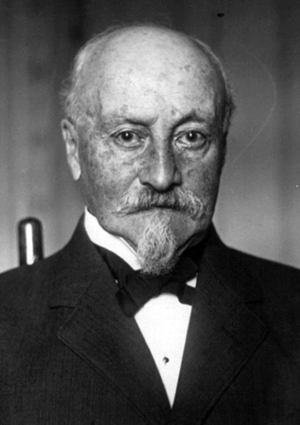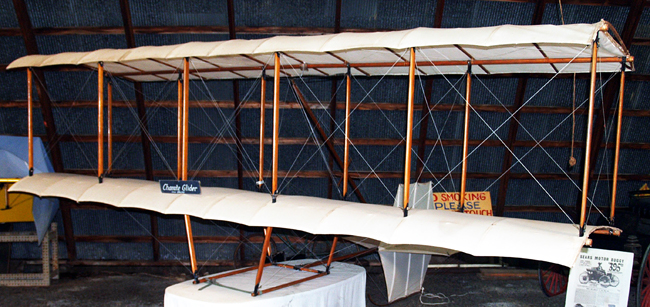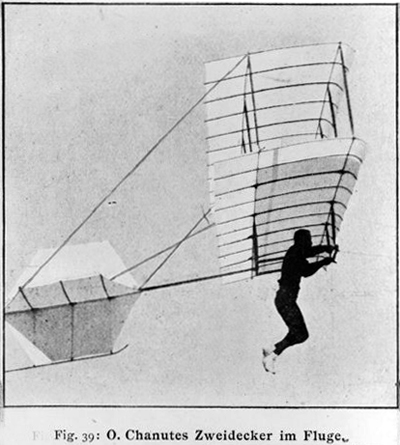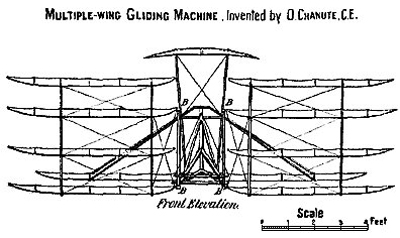Octave Chanute
Today, Octave Chanute. The University of Houston's College of Engineering presents this series about the machines that make our civilization run, and the people whose ingenuity created them.
When Octave Chanute died in 1910, Wilbur Wright delivered his eulogy. Thank heavens! It would've been very sad if the bad feelings between Chanute and the Wright Brothers had not ended.
 You see, Chanute was a leading American pioneer of flight. The gliders he'd designed flew on sand dunes south of Lake Michigan in the summers of 1896 and '7. The Paris-born Chanute had come to America when he was young. He taught himself engineering and was chief engineer of the Erie Railroad by age 41.
You see, Chanute was a leading American pioneer of flight. The gliders he'd designed flew on sand dunes south of Lake Michigan in the summers of 1896 and '7. The Paris-born Chanute had come to America when he was young. He taught himself engineering and was chief engineer of the Erie Railroad by age 41.
Then he returned to Europe in 1875 and was captivated by the interest in flight that he found there. He retired soon after and went to work, full-time, developing gliders. This down-to-earth engineer had entered a domain of crazy inventors.
But surely, he argued, flight would have to become the province of professional engineers. So, in 1885, he organized a session on flight at the meeting of the American Academy for the Advancement of Science.
Chanute managed to get a pre-eminent engineer of that age, Robert Thurston, to write a paper for the session. But his keynote speaker was a disaster -- a famous builder of model birds who served up bad science mixed with cockamamie theory. Win some, lose some. Chanute had managed to fling the gauntlet of flight into the arena of respectable engineering. Now he became a one-man clearing house for the international community of would-be fliers.

Replica of the Chanute hang glider shown in the photo below. From the Old Rhinebeck Aerodrome.
 He and his small team built and flew the most advanced gliders before the Wright Brothers. One flew almost 400 feet. And yet, Chanute the engineer was not cast in the mold of the early airplane inventors. He played a different role.
He and his small team built and flew the most advanced gliders before the Wright Brothers. One flew almost 400 feet. And yet, Chanute the engineer was not cast in the mold of the early airplane inventors. He played a different role.
For years he'd sorted false claims from valid ones and sifted among designs. He gave money to other people's experiments. He labored selflessly to send humans into the sky. He brought common sense to a field drenched in snake oil. When his gliders finally flew, they were less inventions than public demonstrations of the true state of the art. By then, this grand old man of aeronautics was too old to fly. His assistants got to make the actual flights.
The Wright Brothers read Chanute's book, Progress in Flying Machines, and they wrote to him. He quickly saw the genius of those two quiet young men. So he sent his own assistants to North Carolina to work with them. By 1902, the Wrights were making 600-foot flights in fully controllable gliders. The airplane was finally ready for an engine. The next year they took off and flew under power.
But then the Wrights tangled in patent disputes. Chanute hated secrecy and that was anathema. He'd devoted his life to making aeronautical knowledge public. He broke off with the Brothers; but things finally mended. Now Wilber was giving Chanute's eulogy.
So we'd learned to fly at the nexus of entrepreneurial invention and solid professionalism. It was a moment when the two opposing faces of engineering -- each at its best -- came together.
I'm John Lienhard at the University of Houston, where we're interested in the way inventive minds work. (Theme Music)
T. D. Crouch, A Dream of Wings: Americans and the Airplane 1875-1905. (Washington, D.C.: Smithsonian Institution Press, 1989). See the Wikipedia article on Chanute.
O. Chanute, Progress in Flying Machines. (New York: Dover, 1997/1894). This reprint may be read on line here.
This is a greatly revised version of Episode 288.
Images: Chanute's image courtesy Wikipedia Commons. The Chanute gliders are courtesy of the National Air and Space Museum. Glider replica photo by J. Lienhard

Chanute's multiwinged Katydid glider